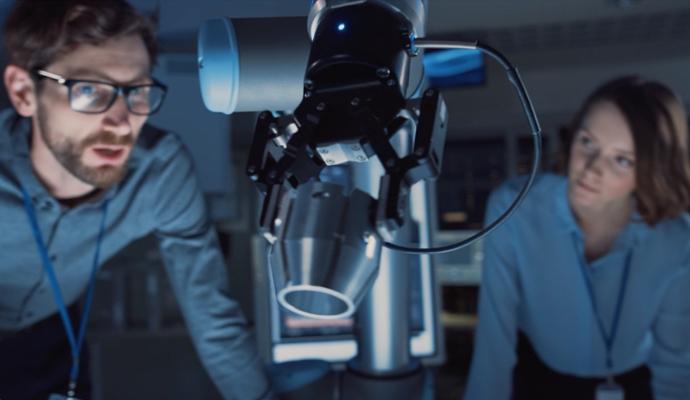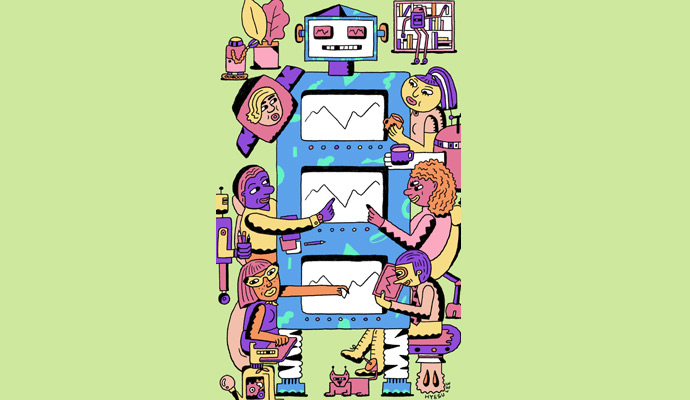Boston Dynamics wants to change the world with its state-of-the-art robots
CEO Robert Playter dispels worries about the potential harm robots could inflict and thinks they will empower people instead of displacing them.

This interview is part of the Inside the Mind of the CxO series, which explores a wide range of critical decisions faced by chief executives around the world.
Robert Playter’s appointment as CEO of Boston Dynamics in 2019 came at an important crossroads for the company. Known for producing some of the world’s most iconic and advanced robots, the company was grounded in research and development (R&D). Its deep roots at the Massachusetts Institute of Technology (MIT) and frequent collaborations with the Defense Advanced Research Projects Agency (DARPA), which is the R&D wing of the US Department of Defense, had produced humanoid robots that could jump and vault through obstacle courses, as well as canine-inspired robots that could climb stairs and walk over rough terrain.
But Boston Dynamics, which was acquired by Google in 2013 and sold to SoftBank in 2017, was in the process of transforming into a full-fledged product company. The goal was to provide robots to clients and customers commercially, and the company’s 2021 acquisition by Hyundai Motor Group sealed the strategy. The Korean car manufacturer was eager to profit from Boston Dynamics’ robotics and artificial intelligence (AI) know-how. For its part, Boston Dynamics could use Hyundai’s expertise in scaling up its activities for the commercial market. Recently, the company unveiled “working” robots that attempt to negotiate job sites, setting up warehouse ramps and delivering tools to human colleagues.
Playter—whose PhD in aerospace, aeronautical, and astronautical engineering at MIT included programming the world’s first robot somersault—had to start hiring non-researchers, a process that he now describes as one of his biggest challenges. The company went from 100 to 700 employees within a few years, and according to Playter, he had to guide the merger of two very different mindsets. The researchers (some of whom, like Playter, had been with the company for decades) suddenly had to work at a faster pace to meet hard deadlines for shipping out products. Conversely, the newly hired product specialists had to work at a slower pace than they might have been used to, because a lot of the new departments had to be built from scratch—including customer service and sales.
Playter sat down with strategy+business to talk about the company’s ongoing transformation, the role that robotics plays in powering the next evolution in business, and the importance of human leadership at even the most tech-enabled company.
S+B: How did you settle on the strategy to transition into a full-fledged product company? Why was the timing right?
PLAYTER: The transition to a product company didn’t happen overnight—it was a slow transition, with the acquisition by Google in 2013 being the initial catalyst. We really began thinking through how our technologies could be used by industries, and what it would take to make a reliable robot that could function outside a controlled environment. Then, when SoftBank bought us in 2017, we became even more focused on releasing commercial products, which became our core focus by the time Hyundai purchased a majority stake in the company. Hyundai’s expansive manufacturing and global sales expertise is particularly valuable for us as we continue to grow.
S+B: The company underwent a huge transition under your leadership, including expanding from 100 to now 700 employees, and shifting focus from R&D to shipping products—which required expertise beyond having smart engineers. How has this transition been?
PLAYTER: Well, one of the big challenges was shifting the mindset of the people who are here. We had to change everybody’s mindset: we’re going to deliver a product, and there’s going to be service and support, and we have to work on those last issues that are required to make a product reliable and trustworthy. That’s a big shift. But honestly, our people are excited by that mission. Many of our early employees have been working for ten or 15 years developing advanced technology. For them, it’s a natural culmination of a career to be able to turn that advanced development into a deliverable product that makes somebody happy at the end of the day. But it has been a big shift, we’ve grown tremendously, and we’ve had to learn new skills.
S+B: “Spot” is the first robot you have launched, and it is used at industrial inspection sites for work that is considered too dangerous for people. Did you target this industry from the start?
PLAYTER: No. To be honest, we weren’t sure. This was the first legged-robot product of its kind, and we weren’t sure what industries it could be a good fit for. We’re finding traction in industrial inspection applications, electric utilities, manufacturing sites, chip foundries, construction sites; they’re all using the robot to do maintenance inspections on a regular basis. We started selling Spot in early 2019, the first 100 to a select set of customers. We now have over 1,000 units out in the field for a wide spectrum of industries.
We used that early adopter program to really do an exploration, and the inspection application was one of the surprises that came out of it. We were not thinking in advance about industrial inspection as a potential client. But we began seeing a preponderance of customers who wanted to attach a sensor, a thermal camera, an acoustic sensor, or a visual camera to read an analog gauge. We started responding to that demand; we iterated and focused in on that industrial application, developing tools around Spot and building out the product portfolio.
S+B: How important is it to adapt and be flexible when launching a new product?
PLAYTER: It’s been a challenge. We were going into this and adapting to what we saw in the market. But it also meant we had to change the product on the fly. And this comes down to the nimbleness of launching new products. I think you have to be able to respond quickly, making changes to the product to suit the needs of the customer, especially when you have an ill-defined market in the beginning. This is a brand-new product in a new market—so we’re having to build both from scratch. It really is a process of discovery and rapid iteration, which are principles of Boston Dynamics. We like to build something, test it, and learn from that.
S+B: How does this trial-and-error phase you’re currently in impact your reputation and how you build trust with your current and future clients?
PLAYTER: This is really critical because we’re introducing a new, immature product. There are going to be problems with these early products that we didn’t anticipate, or simply haven’t had time to fix yet. We find that transparency with the customer is really important. We need to be honest about what’s working and what isn’t.
We have a process that we are using specifically with the launch of our latest robot, “Stretch.” When we go out and do a pilot with clients like DHL or Maersk, we follow up with a report called an “after-action review”: here’s what worked; here’s what didn’t; here are the failures we’ve identified along the way, and this is what we’re doing to fix them. That level of transparency is kind of challenging to do, because you have to admit weakness in front of the customer. But the benefit is that next time you come back, you can say: look, I fixed that thing, we measured improvement. And that—the customer observing that you did exactly what you said and seeing the improvement—really builds trust. And I’d say trust is one of the most important assets you can have when you’re launching a new product.
One of our clients is Ontario Power Generation (OPG), from Canada. They use Spot to disconnect high-voltage equipment. We were just blown away by that application. We’ve launched Spot with an arm that you can control through the interface. And as you can imagine, if you’re going to do this disconnect job, there’s a couple of precise tasks you have to consider. You have to flip up a guard, press a button, and then unscrew this piece of equipment. The fact that OPG was able to get its robot to do this without our help impressed us. But again, this is helping us now understand the direction that the market wants us to go. We bought that piece of equipment OPG used; we have that in our lab. And we’re working on tools to make it easier to do tasks just like that.
S+B: Stretch, your newest robot, is mainly used for loading and unloading tasks in a warehouse environment. What’s been your experience of the launch of your second product?
PLAYTER: I have been with the company for 30 years, but I have never seen this kind of interest in something the company produced. We’ve already got agreements in place for hundreds of Stretches, and we started delivery in the first quarter of this year. We’re able to sell these robots in advance, which is new for us. And we’ve got a big challenge ahead: scaling up, organizing manufacturing, and building a high-quality and reliable product. We’re going to carefully roll it out to a small set of customers at the start, making sure we can keep them happy.
We’ve already done pilots where we have taken the product on-site with DHL, Maersk, and a few others. We began delivering the first units in January of this year. It’s a big moment for us!
S+B: What have you learned from the pilots?
PLAYTER: We see Stretch as being a labor enhancer. It’s not going to replace most jobs. There may be some displacement and changes to how warehouse jobs function today—but the robot needs to be managed by the people who used to do the unloading. Building robots that are easy to operate means it’s not going to take someone with an advanced degree to do so. Our robots are really going to be a power tool for people who would be working in that place already. It’s important that we convince those working alongside robots and get them excited about this technology. Employees in these warehouses are excited to have the opportunity to work with advanced technology, and they see that as a path for advancing their own skills.
Building robots that are easy to operate means it’s not going to take someone with an advanced degree to do so.… It’s important that we convince those working alongside robots and get them excited about this technology.”
S+B: You’ve noted elsewhere anxieties around the impact of AI and large language models, like ChatGPT. Will we one day be able to have conversations with your robots? And, more importantly, how do you mitigate concerns about veracity and the safety of the technology?
PLAYTER: We see real benefits to integrating large language models, of which ChatGPT is just one, with robots. Being able to converse verbally or even through gestures with a robot will help communication between the technology and humans. This will ultimately expand the robot’s utility and enhance its ease of use. While there are potential risks with this technology, we believe more in its potential and creating boundaries to mitigate any risk. This integration, like all applications of our robots, must adhere to our terms and conditions and ethical principles, which strictly prohibit weaponizing the robots or using them for purposes of harm or intimidation.
S+B: What do you make of the dystopian view of robots taking over control and causing people harm?
PLAYTER: It’s a fascinating dystopian story that sticks in people’s brains, and it influences how they react when they start to see humanoid robots, or robots that look like dogs. I remind people that the robots are not nearly as smart as they are portrayed to be in these movies. We are working hard to portray robots as being helpful, working alongside us and assisting us. They are not in charge and don’t have their own sense of agency. We are working hard to dispel any worries about them being used to cause harm. That’s where our anti-weaponization policy comes in; we even spearheaded an open letter against weaponization, signed by five other leading robotics companies. I want people not to be afraid of robots, and it’s important that we try to counter that dystopian point of view.
S+B: Could you tell us a little more about this anti-weaponization policy?
PLAYTER: We think that as general-purpose robots are becoming more common—and they are—people could misuse them. You can find videos online showing how easy it is to attach a weapon to a mobile robot. So, there’s a reasonable concern about who will have access to robots and what they can do with that access. We want to make sure that there will be some regulation around this—and lead the charge in getting it put into place. Policymakers need to get engaged and be informed about the capabilities of the robots, as well as the potential dangers. We are being vocal about our anti-weaponization stance: robots should not cause harm, nor should they impinge upon anybody’s privacy. The industry that we’re hoping to build only exists if people trust robots. If they’re afraid of them, then that’s going to be a problem.
S+B: Reliability and high costs are often cited as the two big challenges for robotics manufacturers to overcome when launching a product. How did Boston Dynamics deal with these?
PLAYTER: These factors are especially challenging when you’re launching a brand-new product, and you’re having to rapidly iterate the design to meet market demands. As the product changes, your reliability work has to be redone. But we’ve tackled that head-on. In the case of Spot, for example, we have a fleet of robots running 24/7 that allow us to measure quality and reliability. So, every week, that fleet walks an accumulative distance of about 1,000 miles and racks up about 1,500 hours of operation. This allows us to collect enough data so we can begin finding the rare, but important, failures that are still there. And some you can only track down after thousands of hours of operation. And that’s what enables us to rapidly improve, identify failures, and issue design changes.
For the manufacturing, we have set up our own facility here in Waltham [Mass.]. We’re building Spots and Stretches just one mile down the road. By managing the final assembly ourselves, we have better control over the quality and cost, and it helps us to rapidly iterate. One of the things we have learned is that when you iterate your design and work with a partner to do the assembly, the communication challenges are pretty thick. It’s hard to keep moving the goalposts for your contract manufacturer. By bringing manufacturing in-house, we remove those communication barriers and can be nimbler in rolling out changes.
S+B: How does the “war for talent” impact your hiring practice?
PLAYTER: And of course, we need some of that talent too; we feel that pressure when it comes to wages. We have to compete. We are a 700-person company, and honestly, we’re up against folks like Google, Tesla, and Facebook—huge, profitable companies. It feels like David and Goliath. But the stone that we have, and that none of them have, is that we have the coolest robots in the world to work with. And for a lot of these people, that’s important. It’s not just the coolness of technology, it’s the vision of what robots can do, and the world we all want to create.
That’s key for attracting talent. People want to be connected to a mission that they have confidence in and are excited about. We have the opportunity to change the world in a way that not many companies do. And that’s a strong draw. This is important not only for us. I think it’s part of Hyundai’s goal in buying us as well. Car companies are going to be remade, and acquiring talent is the best tool for being ready for what could be a major pivot in the automotive industry.
S+B: What’s the ultimate goal?
PLAYTER: You know, I don’t think we’re totally there yet. Spot is on a path to success, but honestly, it has a ways to go yet. And we’re starting to see customers who are using the robots regularly in ways that we think can then scale. An awful lot of our sales have been small unit numbers to innovation teams who are experimenting with these applications. And by focusing on these manufacturing applications, we see opportunities to scale to tens and hundreds of units at a single customer. I think we need to get there before we start to claim success with Spot.
With Stretch, of course, we’re just on the verge of launching. It’ll be three years before we’re really starting to scale out sales. It’ll take us a little time to ramp up production and make those models successful. And of course, our dream is to become a serial robot company, building products so that after Stretch, there can be a third robot. That might be a derivative of the previous two models, or it might be something entirely new, along the lines of the kinds of things we’re doing with “Atlas,” Boston Dynamics’ bipedal humanoid robot.
S+B: What have you learned about yourself as a CEO from the company’s transition?
PLAYTER: You just have to jump in and start doing it—don’t be afraid. If you commit yourself to doing it, you can learn what you need to learn. We have amazing, talented people, and this becomes commensurate with changing a culture as well, bringing in a lot of people who have the experience of working in a product company but do not have experience working in an R&D company. Those two groups really have two different kinds of mindsets. We’re going to get products out quickly because we need feedback from the market. The researchers won’t be comfortable, nor will the product people. We’re all going to be uneasy in this in-between space where we’re moving more slowly than a product company, but more quickly than a research company.
Author profile:
- Bobbie van der List is a correspondent for Dutch newspapers and magazines. Based in Tokyo, he specializes in business- and management-related topics.




